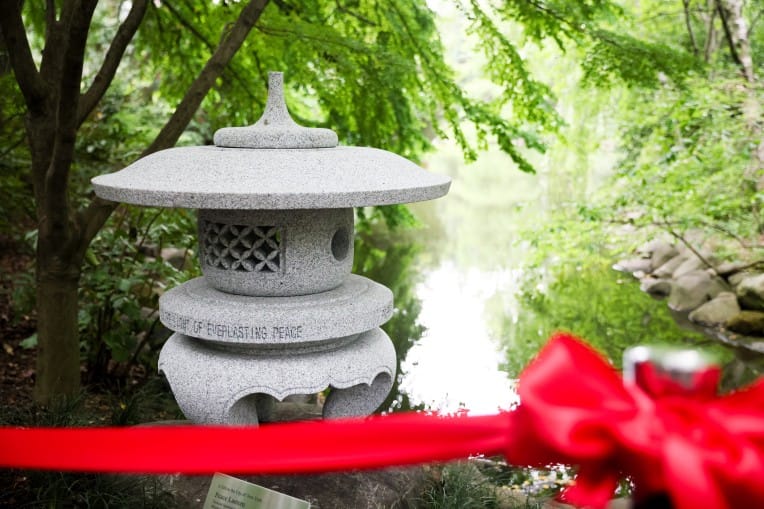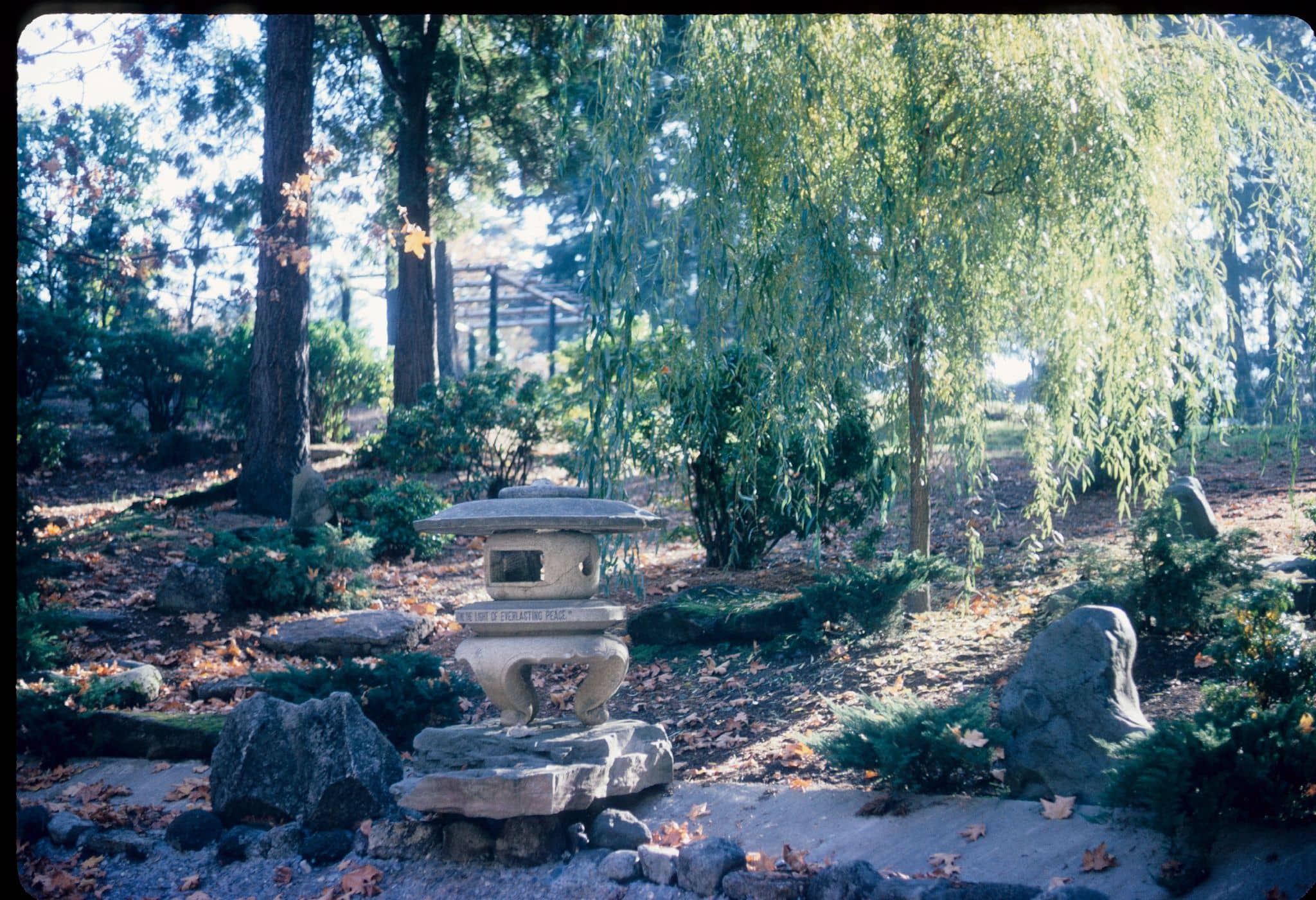
In June, Portland Japanese Garden, through its sibling organization and global cultural initiative, Japan Institute, formally presented a handcrafted replica of its beloved Peace Lantern to one of the most revered and famous public gardens in the United States, Brooklyn Botanic Garden. Among those who spoke at this auspicious event was Portland Japanese Garden and Japan Institute CEO Steve Bloom.
“Japan Institute was borne from what we have witnessed at Portland Japanese Garden for nearly 60 years—how the intersection of culture, art, and nature can help provide a better understanding of ourselves and one another,” Bloom shares. “As a leading global public garden, Brooklyn Botanic Garden is proof that these kinds of institutions have an important role to play in fostering mutual understanding, community-building, and social change. In recognition of these shared values, we presented a gift of a Peace Lantern as a tangible symbol of cultural diplomacy, friendship, and peace.”
The History of the Peace Lantern

The original Peace Lantern this gift is based on is one that the City of Portland received from Mayor Ryozo Hiranuma of Yokohama, Japan in 1954. Conveyed to Portland on one of the first Japanese ships to arrive on the American West Coast after World War II, the lantern is a stately yukimi doro (short stone lantern with as many as six legs) stylized in the snow lantern form. Its firebox is directly underneath a broad sloping roof resembling a traditional Japanese hat made from rush (kasa). In English, a message of hope is inscribed in capital letters: CASTING THE LIGHT OF EVERLASTING PEACE.
Related: Read the Full History of Portland Japanese Garden’s Peace Lantern
After being initially installed in Portland’s International Rose Test Garden, it was subject to repeated vandalism by those with festering hostility toward Japan in the aftermath of the war. It was moved to the eastern bank of the Strolling Pond Garden’s upper pond in Portland Japanese Garden in 1966 and has remained there as a beacon of hope and friendship to this day.
Carrying on the Legacy of Giving Gifts of Peace

The Garden initially began donating handcrafted replicas of the Peace Lantern in 2017, the first city being Yokohama, Japan. As the Japanese city was preparing for the nation’s prestigious Annual National Urban Greenery Fair, Portland Japanese Garden Curator Emeritus Sadafumi Uchiyama was approached for advice from his sensei, landscape architecture expert Professor Isoya Sinji, who sought to include something tangible and symbolic to the proceedings. After a series of conversations and a pair of stone masons visiting Portland to take measurements, a replica was crafted and installed in Yokohama’s Higa-en, a small yet handsome park.
Spurred on by this initial success, Portland Japanese Garden and its global cultural initiative and sibling organization, Japan Institute, have donated handcrafted replicas of the Peace Lantern around the world. The Garden would present a lantern to Sapporo in 2019, a fitting gesture borne out of a long-lasting sister-city friendship established by the Japanese municipality and Portland in 1959.
Related: Read About the Sapporo Pagoda Lantern, A Gift From Sapporo
Following the establishment of Japan Institute in 2022, the Garden’s sibling organization took on the oversight of making these meaningful gestures. The organization donated Peace Lanterns to Hiroshima and Nagasaki, cities that have overcome ruin to become world leaders in spreading the message of peace. In Hiroshima, the Peace Lantern has been placed on a green belt that runs parallel to the city’s Peace Memorial Park. In Nagasaki, the Peace Lantern resides in a space where millions of visitors pass by on their way to the Nagasaki Atomic Bomb Museum. Additionally, the organization would contribute a handcrafted replica to Tokyo ahead of its inaugural Peace Symposium there, a fitting location as Japan’s capital had dotted the globe with gifts of peace just as Yokohama did. Japan Institute would cap 2022 off with the presentation of one more lantern to a major global city, but for the first time, one outside of Japan. In recognition of a mutual desire to foster long-lasting peace through nature, Japan Institute gifted a Peace Lantern to the Japanese Landscape of the Royal Botanic Gardens, Kew in London, England.
Another Peace Lantern on American Soil

This gift marks the first time Japan Institute has donated a Peace Lantern to an American site. There might be no more fitting location to join Portland Japanese Garden. As Brooklyn Botanic Garden notes, their Japanese Hill-and-Pond Garden, opened in 1915, “is one of the oldest and most visited Japanese-inspired gardens outside Japan. Designed by Japanese-American landscape architect Takeo Shiota, the Japanese Hill-and-Pond Garden was the first Japanese garden in an American public botanic garden, blending the ancient hill-and-pond style and the more recent stroll-garden style, in which various landscape features are gradually revealed along winding paths. The garden features artificial hills contoured around a pond, a waterfall, and an island, along with carefully placed rocks. Architectural elements include wooden bridges, stone lanterns, a viewing pavilion, a Shinto shrine, and a dramatic vermilion-colored wooden torii [traditional Japanese gate, commonly found adjacent to Shinto shrines].”
The two public gardens also share a common thread in Professor Takuma Tono of Tokyo Agricultural University (1891-1967). Professor Tono was the original designer of Portland Japanese Garden and was the progenitor of the idea that the attraction should contain multiple garden styles, each depicting aesthetics tied to specific historical eras in Japan. Before Tono was retained by the Garden, he had become known in the gardening community through his recreation of the famed raked gravel garden of Ryoanji at Brooklyn Botanic Garden. The idea of a garden where the only plant life would be incidental moss was, at the time, astonishing to many Westerners, to the degree that Tono’s work inspired an article in a 1963 issue of The New Yorker, where its writer grappled with the concept of what a garden could actually be.
To help figure out the proper location for its installation, Hugo Torii, Garden Curator of Portland Japanese Garden visited Brooklyn ahead of his colleagues earlier in the month. After meeting with Brooklyn Botanic Garden’s staff, Torii worked alongside members of their team, including Vice President of Horticulture, Rowan Blaik, and Director of Horticulture, Shauna Moore to physically place the lantern near a path. Torii described the location, an intersection that is near more than 200 cherry trees, as a “beautiful setting” and was touched by his counterparts’ genuine appreciation for the Peace Lantern.
A Symbol of Good Luck Joins the Symbol of Peace

The presentation of the Peace Lantern, which included leadership from both gardens, was made all the more auspicious by a guest who decided to fly in for the proceedings: a crane. In Japan, the crane, or tsuru, is a national treasure and is considered the bird of happiness. It is depicted in art, literature, and mythology as a symbol of good luck and longevity because it is said to live 1,000 years. In more recent years, particularly after World War II, the crane has become a symbol of peace, hope, and healing during challenging times.
Adrian Benepe, President and CEO of Brooklyn Botanic Garden, who stopped to acknowledge the presence of the feathered guest, was the first to deliver remarks and shared incredibly kind words about Portland Japanese Garden. “We aspire to be as a great a Japanese garden as the one in Portland,” he remarked. “We’re good. They’re great. If you haven’t been there and you want to see the best Japanese style garden outside of Japan, you need to go to Portland, Oregon.”
“Brooklyn Botanic Garden is honored to receive this symbol of peace for our Japanese Hill-and-Pond Garden,” Benepe also shared. “We thank Japan Institute of Portland Japanese Garden for bestowing this beautiful lantern, which represents the friendship and shared mission between our two institutions as well as unity among all the Peace Lantern sites. Generations of New Yorkers and visitors from around the world have come to Brooklyn Botanic Garden’s Japanese Hill-and-Pond Garden to find tranquility and restoration, and generations more will encounter and be inspired by this new symbol of peace.”
“It’s a thrill to see our Peace Lantern in Brooklyn Botanic Garden,” shared Lisa Christy, Executive Director of Portland Japanese Garden, after the event concluded. “Brooklyn Botanic Garden has one of the oldest and most visited Japanese-inspired gardens outside Japan. Having our Peace Lantern here not only brings this message of peace and hope to so many more people around the world but marks a budding coast-to-coast partnership for peace for years to come”





